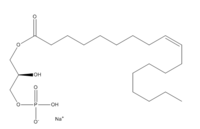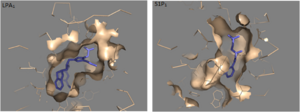Sandbox Reserved 1175
From Proteopedia
| This Sandbox is Reserved from Jan 11 through August 12, 2016 for use in the course CH462 Central Metabolism taught by R. Jeremy Johnson at the Butler University, Indianapolis, USA. This reservation includes Sandbox Reserved 1160 through Sandbox Reserved 1184. |
To get started:
More help: Help:Editing |
Contents |
Human Lysophosphatodic Acid Receptor 1
Lysophosphatodic Acid
Function
LPA, a signaling phospholipid, can attach to three specific G-protein-coupled receptors. LPA can activate multiple pathways in particular, Ras and Pho which belong to the family of GTPases. Another use of LPA is it can help in stimulation of cell migration [1].
Structure
| |||||||||||
Clinical Testing
LPA is still in the clinical stage of testing. So far the LPA receptors have had physiological effects on every organism that it has been tested with. There have been studies done looking at what happens with infertility, fibrosis, pain, and cancer when they come into contact with LPA receptors [2]. LPA receptors are commonly found in serum and saliva. [1].
Pain
LPA, a signaling phospholipid, that attaches to three specific G-protein-coupled receptors. After an injury occurs LPA is released in the body. It then will activate G-protein-coupled receptors. Within the nervous system, LPA plays a role in the nociceptive process (nociceptive pain is a sharp pain that can come from a mild burn or twisted ankle). The LPA signaling will activate GTPase RhoA. Once activated Rho translocates to the plasma membrane. Rho will activate Rho kinase (ROCK). Mice with the deletation of LPA1 receptors were studied to see the role that LPA signaling played in pain. In a study done with mice, those without the LPA1 receptor had lower levels of pain.[3]. Another use of LPA is it can help in stimulation of cell migration [1].
Fibrosis
To better understand the role the LPA plays in fibrosis, a study was done with mice who had contracted fibrosis [4]. Idiopathic pulmonary fibrosis (IPF) has high rates of mortality. Research has been done to study the pathway of the LPA-LPA1 in fibroblast migration ([1]). The bronchoalveolar lavage (BAL) in mice that had fibrosis was elevated. The research supported the hypothesis that LPA1 plays an active role between lung injury and contracting pulmonary fibrosis.
References
- ↑ 1.0 1.1 1.2 Moolenaar WH, van Meeteren LA, Giepmans BN. The ins and outs of lysophosphatidic acid signaling. Bioessays. 2004 Aug;26(8):870-81. PMID:15273989 doi:http://dx.doi.org/10.1002/bies.20081
- ↑ 2.0 2.1 2.2 Chrencik JE, Roth CB, Terakado M, Kurata H, Omi R, Kihara Y, Warshaviak D, Nakade S, Asmar-Rovira G, Mileni M, Mizuno H, Griffith MT, Rodgers C, Han GW, Velasquez J, Chun J, Stevens RC, Hanson MA. Crystal Structure of Antagonist Bound Human Lysophosphatidic Acid Receptor 1. Cell. 2015 Jun 18;161(7):1633-43. doi: 10.1016/j.cell.2015.06.002. PMID:26091040 doi:http://dx.doi.org/10.1016/j.cell.2015.06.002
- ↑ Inoue M, Rashid MH, Fujita R, Contos JJ, Chun J, Ueda H. Initiation of neuropathic pain requires lysophosphatidic acid receptor signaling. Nat Med. 2004 Jul;10(7):712-8. Epub 2004 Jun 13. PMID:15195086 doi:http://dx.doi.org/10.1038/nm1060
- ↑ Tager AM, LaCamera P, Shea BS, Campanella GS, Selman M, Zhao Z, Polosukhin V, Wain J, Karimi-Shah BA, Kim ND, Hart WK, Pardo A, Blackwell TS, Xu Y, Chun J, Luster AD. The lysophosphatidic acid receptor LPA1 links pulmonary fibrosis to lung injury by mediating fibroblast recruitment and vascular leak. Nat Med. 2008 Jan;14(1):45-54. Epub 2007 Dec 9. PMID:18066075 doi:http://dx.doi.org/10.1038/nm1685


